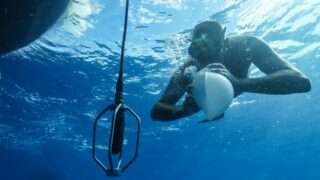OUR ACTIONS & THE LOST LINK

CONFERENCES
FEBRUARY 1, 2020 : WORLD ANIMAL INTELLIGENCE DAY
CITÉ DES SCIENCES ET DE L'INDUSTRIE, PARIS AT 6PM
THE SONGS OF THE WHALES, CONFERENCE AND CONCERT BY PIERRE LAVAGNE DE CASTELLAN
Research Director of the Shelltone Whale Project, Pierre Lavagne de Castellan spoke about whale songs: why do they sing, what are the hypotheses, is it possible for humans to communicate with whales, what is the status of current research? In the second part, he played Shelltonethe instrument he developed with the Ecole Centrale de Nantes and Stanford University in California to communicate with humpback whales. He plays accompanied by whale songs that he himself recorded during his research in inter-species communication. This unique creation will reproduce the exchange that exists today between humans and cetaceans through music.
Co-organised with the support of the Cité des Sciences et de l'industrie.
Here is the very interesting video of his intervention in full version (59 min)
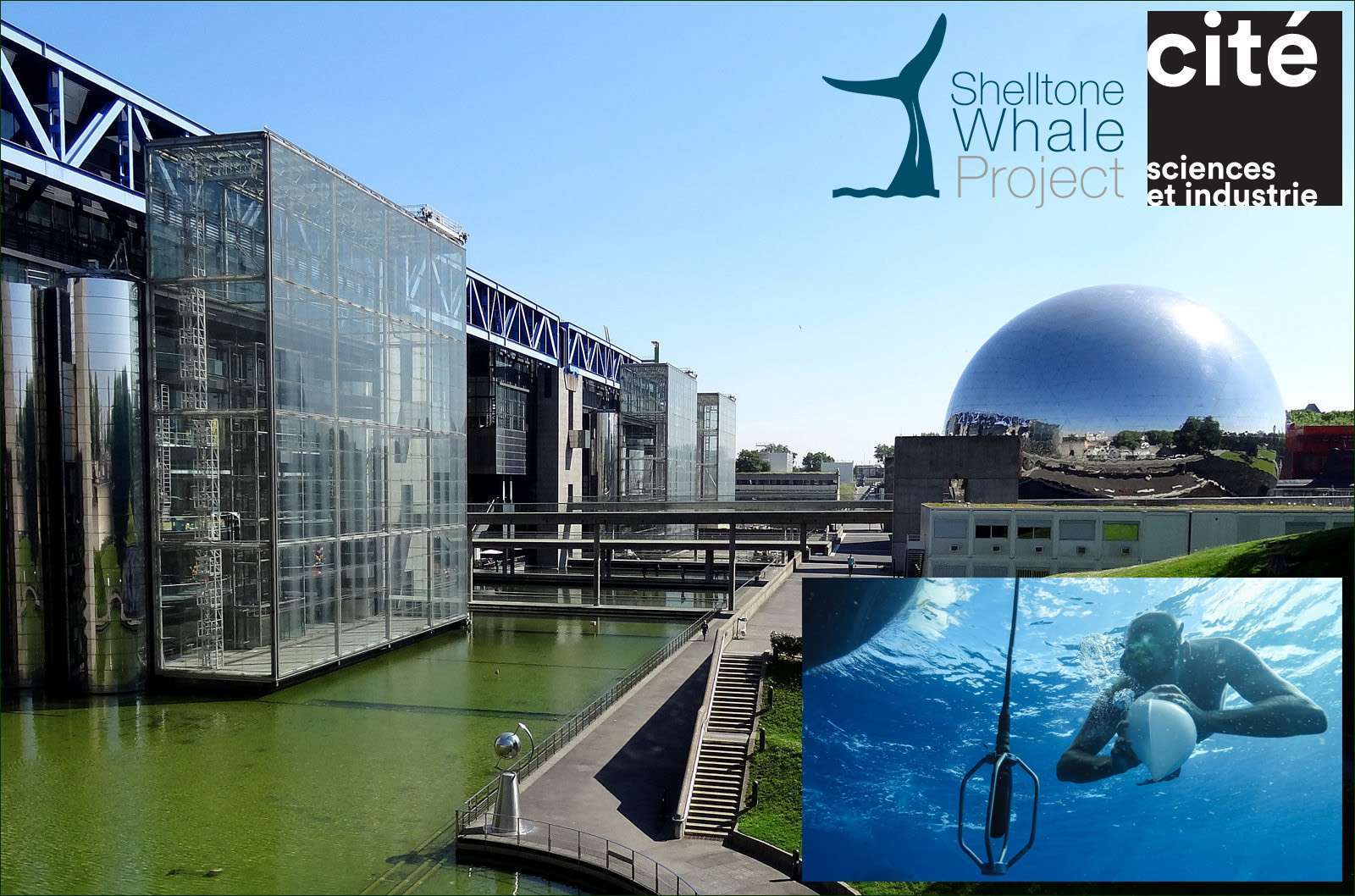
GEOREFERENCED DATA PROVISION AGREEMENT
Between the undersigned:
Shelltone Whale Project, association of law 1901.
Represented by its President, Mr Pierre Lavagne de Castellan
And
The Marine Protected Areas AgencyThe Commission is a national public institution of an administrative nature.
headquartered at
16 quai de la douane, BP 42932
29229 BREST CEDEX 2
Over the past few years, the Agoa Sanctuary has collected a number of data on cetaceans. These data have been acquired by the sanctuary (via various campaigns at sea, the installation of acoustic beacons and the census of opportunistic data...) but also by local actors (associations, research departments, private groups...).
A more detailed study of these data made it possible to identify feeding, resting and socialization areas for several species of marine mammals. In order to obtain more robust results, the Agency is asking the Shelltone Whale Project to enhance its data and knowledge on the subject. This project will be carried out as part of a master's internship starting in January.
This information, assembled in data banks, is then analysed and stored at the centre of the marine protected areas. These observations will eventually provide a visual overview of the state of play in the part of the sanctuary where the Shelltone Whale Project operates, the leeward coast of Guadeloupe, from Deshaies to Basse Terre.
The Agoa Sanctuary is a marine protected area dedicated to marine mammals in the French West Indies.
The objective of the Agoa Sanctuary is to ensure a favourable conservation status for marine mammals by protecting them and their habitats from the direct or indirect, proven or potential negative impacts of human activities.
The Agoa Sanctuary carries out actions to better understand and protect marine mammals and their habitats while promoting a harmonious cohabitation between human and animal activities.
These actions are in line with the overall objective of the sanctuary and its main principles of action: limitation of negative interactions, limitation of pollution, public knowledge, information and awareness, development of monitoring means, cooperation.
PUBLICATIONS
Animals are much more intelligent than we ever thought... Regularly, discoveries are made that enlighten us about their sensitivity, their emotional capacity, their generosity, their solidarity and, dare we say it, their wisdom.
Seven brilliant spirits, with exceptional journeys, take us to this fascinating universe of animal intelligence. Thanks to them, you will discover the incredible powers of whale songs that boost the protein content of the plankton, you will see, with the bonobos, that laughter is not the only thing that makes man laugh. You will understand that you can manage a team by taking inspiration from schools of fish. You'll see that ants invented agriculture long before man...
These examples, and many others, show us that the supremacy of man over animals is pure fiction and that, better still, animals are perhaps the lifeline of humanity through their ability to survive and adapt.
Let's reinvent our relationship with the animal, our survival depends on it!
This book is available here : Larousse
INTERNSHIP AGREEMENT BETWEEN THE UNIVERSITY OF THE WEST INDIES AT PITRE AND THE SHELLTONE WHALE PROJECT
From January 30 to February 24, 2017:
We receive Ms. Océanne Amaya Cipollini, student in L3 life and earth sciences, biology of organisms and ecosystems.
Internship subject: photo identification and acoustic observation of cetaceans, ethology and study of marine mammals in the Agoa sanctuary, from Deshaies to Basse Terre.
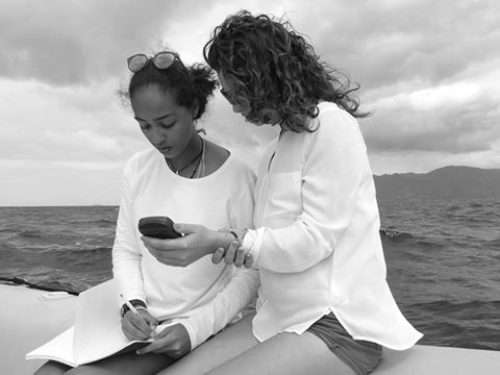
Océanne and Léa at work on the Sec Nord, opposite Baille Argent.
From January 15 to February 9, 2018:
We work with Aurélie Martineau, a student in L3 of BOE (Biology of Organisms and Ecosystems) in Guadeloupe.
Internship subject: Implementation of geo-referenced data of cetaceans of the leeward coast of Guadeloupe, study of the bio-acoustic tool, acoustic identification of species and their behaviour in their environment.
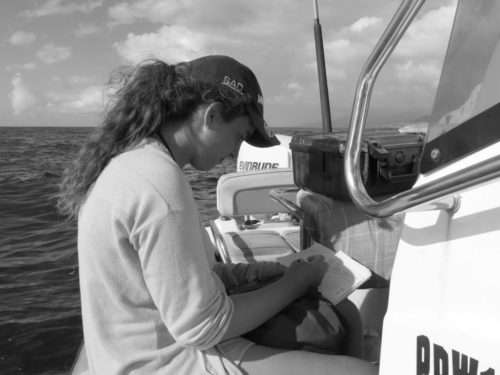
Aurelie at work in the Agoa shrine.
LECTURES ON BOARD THE AMERICAN UNIVERSITY SHIP OCEAN STAR
Regularly, the university ship Ocean Star anchors in Deshaies, the Seamester organization schedules, at each passage, a conference on the Shelltone Whale Project research presented to American marine biology students by Pierre Lavagne de Castellan.
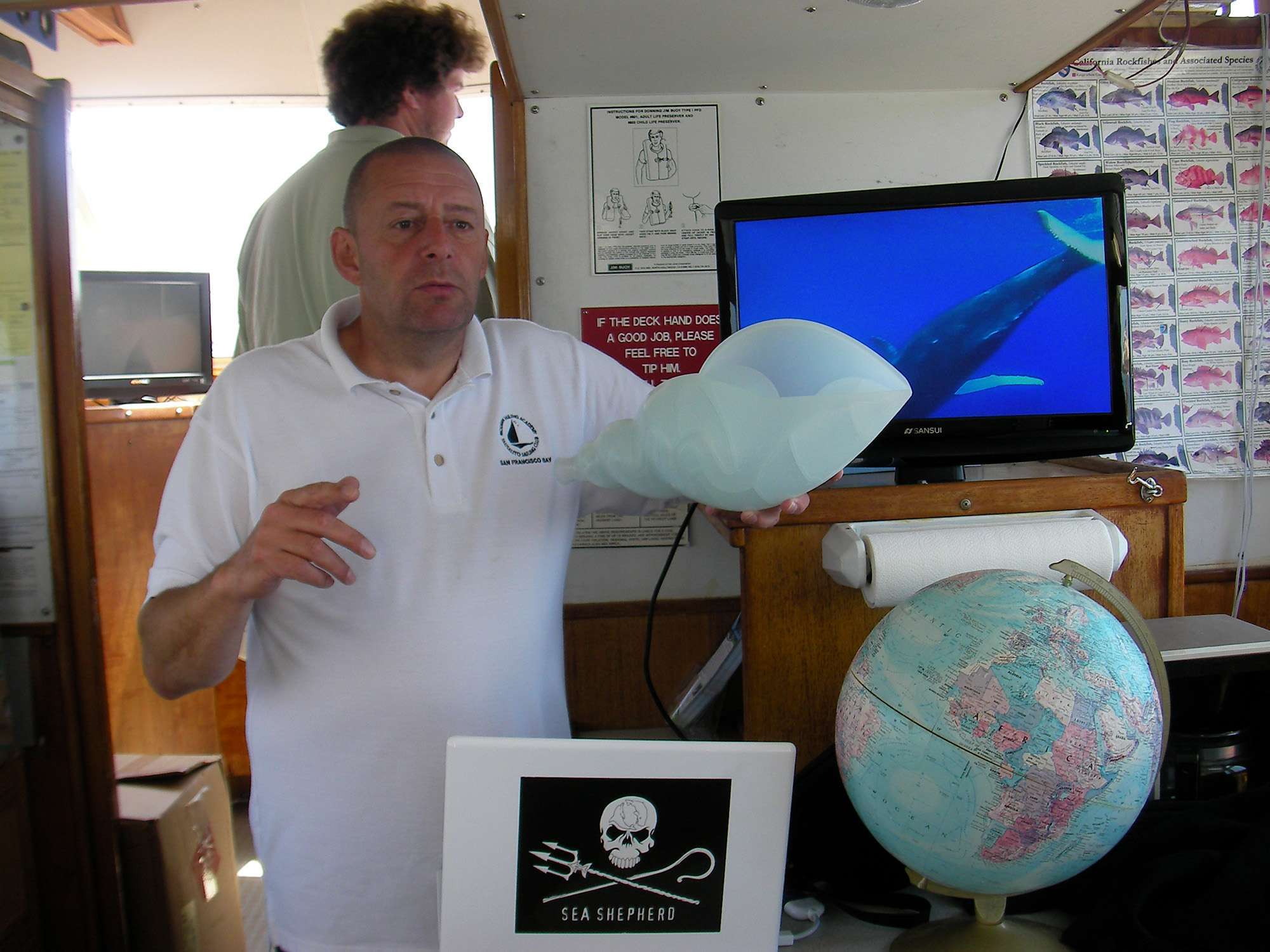
PRESS AND TESTIMONIALS
Télérama, article by Emmanuel Tellier :
Pierre Lavagne de Castellan, the man who sings like a whale...
France Inter, chronicle by Anne Pastor :
The song of the whales
France Antilles of 16/02/15 :
France Antilles
Radio Nova:
Novaplanète
Neoplanet:
Neoplanet
Interview Post-conference Neoplanet :
Interview
Lecture Pierre Lavagne de Castellan University of Animal Intelligence :
Conference
TESTIMONY OF HEATHER HARDING, MARINE BIOLOGIST, MAUI, MAWAII.
Hello, Pierre,
Your legacy still lives on here in Maui. At the last Whaledreamer meeting I had the Shelltone you gave me and I told your story. People who hadn't heard about it were fascinated and inspired.
I don't know if you realize how inspiring this is for people.
The act of creating something, putting one's heart, soul and passion into it without expecting anything in return is in itself a powerful act.
The whales seem to encourage this kind of attitude on our part.
We may not know why we do what we do, but we may believe there is a reason. It is so important that we do these kinds of things more and more, to help balance and heal this world that is sick of the actions of people driven by greed and selfishness, in that your example has value.
I like the Shelltone you gave me. Thank you very much, I cherish it and with it I tell your story to all the people I meet on my whale watching trips, to the students in my classes and at Whaledreamers meetings.
I hope you know how valuable your project is to so many people.
Heather Harding. Marine biologist. Maui - Hawaii - USA
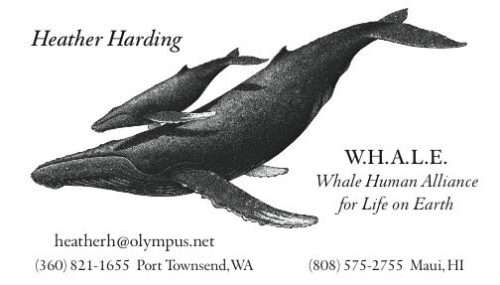
THE MISSING LINK
In all the world's seas, humpback whales have, for thousands of years, nurtured bonds that continue to this day with the people who inhabit the coasts where they live.
We observe everywhere in the world the willingness of humpback whales to approach men, to spend time in their company, to swim with them, to exchange with them their music, their sound... everywhere except in the Caribbean....
Why?
In order to understand, we have to put ourselves in a historical context and realize that the links that whales have with the First Peoples date back several millennia.
When Europeans began to visit and write about the North in the 10th century, they were fascinated by the Aboriginal peoples' relationship with whales. Medieval literature described the Arctic as a land of malevolent "monster fish" and people who could summon them to shore with magical powers and mumbled spells.
Even when explorers and missionaries brought back simple stories about how different whaling cultures hunted, butchered and shared a whale, it was hard to shake off this sense of mysticism. In 1938, the American anthropologist Margaret Lantis analyzed these scattered ethnographic accounts and concluded that Iñupiat, Inuit and other northern peoples belonged to a "circumpolar whale cult.
Lantis found evidence of this in numerous taboos and rituals designed to cement the relationship between people and whales. In many places, a recently killed whale would be given a glass of fresh water, a meal and even travel bags to ensure a safe return to its spiritual home. Each whaler had their own songs to call the whales. Sometimes shamans performed religious ceremonies inside circles made of whale bones. Caches of whaler amulets - an ambiguous word used to describe everything from jewellery shaped amulets to feathers or skulls - were passed down from father to son in whaling families.
For non-native observers, it was so mysterious. So unknowable. And for archaeologists and biologists in particular, it contradicted Western scientific values, which forbade anything that smacked of anthropomorphism.
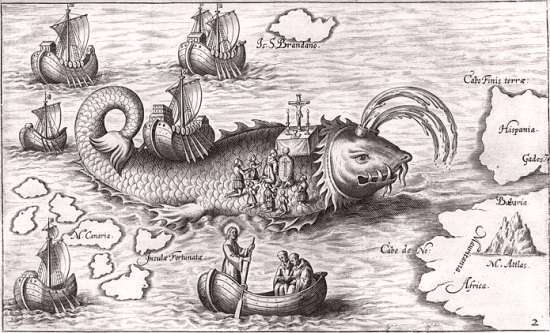
Along some Alaskan coasts, rocks are covered with petroglyphs of men and whales. They were carved by whale shamans as part of rituals that allowed them to learn the secrets of the sea and offer thanks for its generosity.
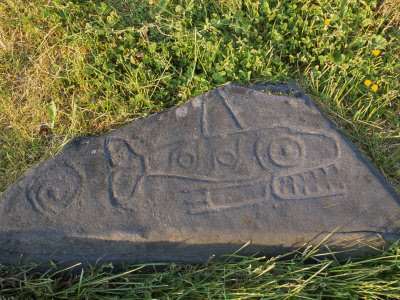
In archaeology, such attitudes have limited our understanding of arctic prehistory," says Erica Hill, a zooarchaeologist at the University of Alaska Southeast. Whaler amulets and bone circles have been considered ritual or supernatural, with little understanding of what they meant to the people who created them. Instead, archaeologists who have studied animal artifacts have often focused on the tangible information they have revealed about what ancient peoples ate, how many calories they consumed, and how they survived.
Hill is part of a growing branch of archaeology that uses ethnographic and oral histories to re-examine animal artifacts with fresh eyes and interpret the past in new, non-Western ways. I'm interested in this as part of our prehistory as humans," says Hill, "but also in what it tells us about other ways of being.
The idea that Aboriginal people have spiritual relationships with animals is so well established in popular culture that it is a cliché. Yet, limited by Western science and culture, few archaeologists have examined the records of human history from the perspective that animals feel emotions and can express those emotions to humans.
Thus the Tinglits of North West America, the Aborigines of South East Australia, the Maori of Kaikoura, the Mayumba people of West Africa, the Hawaiians, the Polynesians and so many others have been able to forge powerful bonds based on respect and often exchange with these whales over several thousand years.
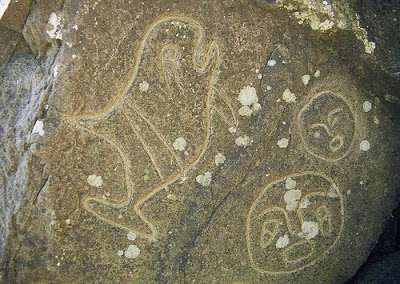
- Respect because these whales are considered by the First Peoples, either as members of the family, the Tinglits in particular consider them as such and the fact that they eat their flesh is assimilated to cannibalism, or as divinities, the Hawaiians call them "Koholas" the goddesses of the sea, who are surrounded by an immense sphere of Mana, pure energy, guardian of spirituality.
- The exchange, because whale songs are found in the shamanic songs of the people who have been listening to them for thousands of years, but also, human melodies can be found in the songs of the whales... ( see The search for the disappeared music of the Kalinagos )
The Lost Caribbean Link
In the Caribbean, pre-Colombian peoples certainly had these same links with humpback whales, these whales considered these peoples as their family, until 1492 .
1492, the arrival of the Europeans sounded the death knell for these civilizations, Kalinagos, Caribbean, Tainos, Arrawaks, these peoples were gradually exterminated or assimilated, their culture and spirituality destroyed. The whales then underwent this genocide of their "family" as a trauma. From then on, a legitimate mistrust of the "new" humans that now populate the Caribbean has taken hold.
Pierre Lavagne de Castellan
Rock painting Taino ( Dominican Republic 4000 years ago ) representing a humpback whale.
The position of this whale cannot be observed from the surface, this position, arched, pectorals at rest, is characteristic of a whale in socialization, the person who painted this whale maybe 4000 years ago used to be with it, underwater...
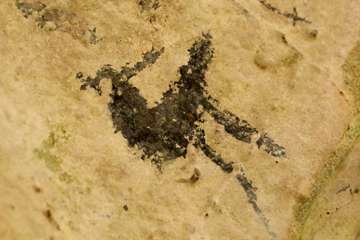
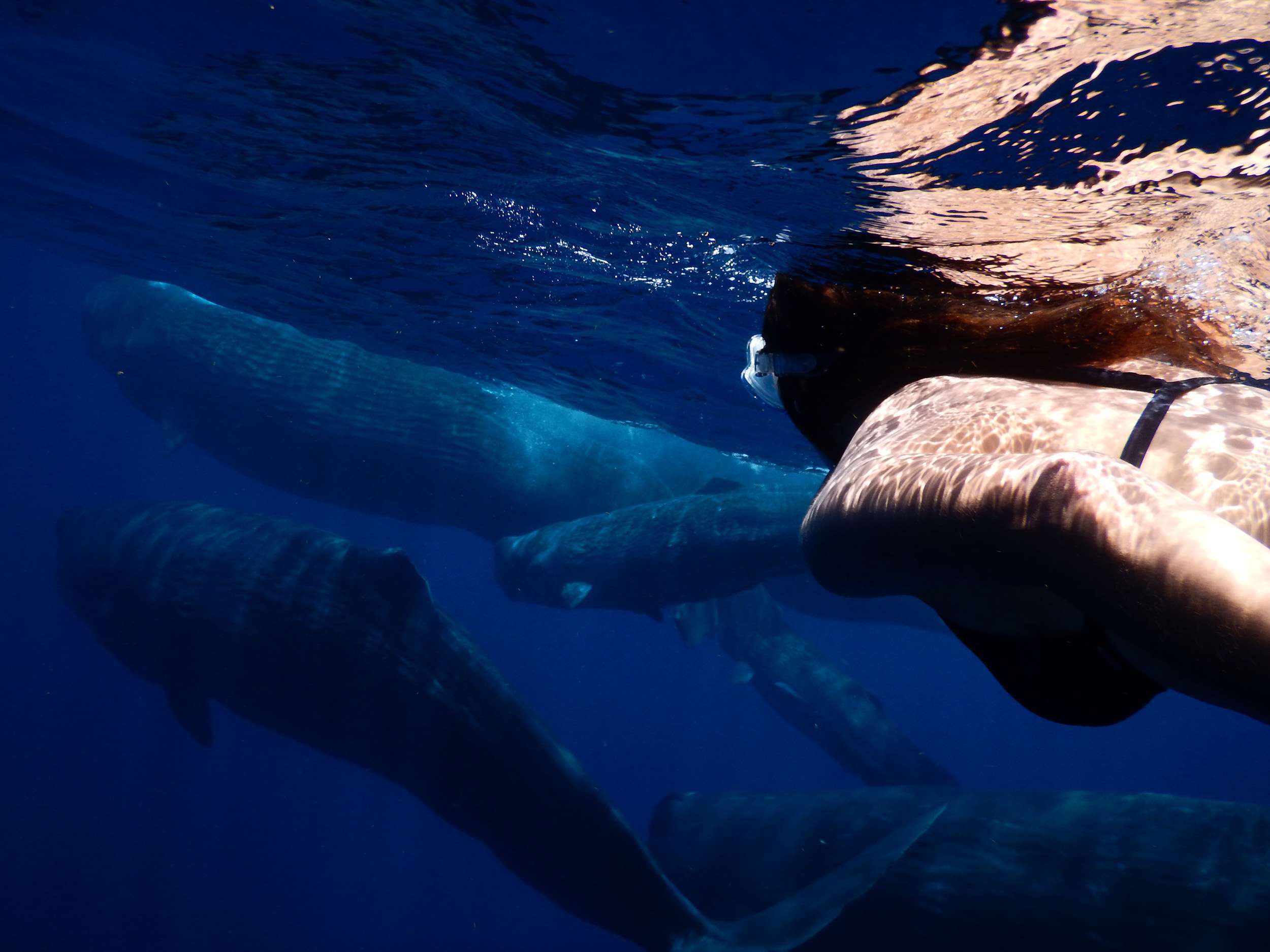
Léa Lavagne de Castellan with a family of sperm whales during our research in interspecies communication, outside the Agoa sanctuary.
OUR MISSION IS TO RECONNECT
Musical interaction with the humpback whales of the Caribbean is the key to renewing the dialogue with these animals... re-creating the link.
The three axes of work:
- On a daily basis, the Shelltone Whale Project team practices inter-species communication with humpback whales in Guadeloupe by using Shelltone to gradually install a musical dialogue between whales and humans. Playing music with the whales allows us to experience a special relationship with them on a daily basis and thus be able to rub shoulders with them, experience moments of intimacy with them, and renew ties.
- At the music school in Petit Bourg, we are preparing the formation of an orchestra of young musicians who will learn the music of the whales and then take them out to sea to play with them.
- We are going to meet musicians and scientists from other Caribbean islands where humpback whales live, in order to initiate multidisciplinary exchanges.
Learning whale music at the music and dance school in Petit Bourg.
- This year, the music school of Petit Bourg, in collaboration with the Shelltone Whale Project, is offering its students the opportunity to follow whale singing and music sessions.
- Each student in this "formation" plays the instrument he usually works on. Pierre Lavagne de Castellan teaches the students the melodies of the whales. The students have to compose their own piece inspired by the whales' songs.
- The idea is that in time, the young musicians will be able to play with the humpback whales, on a catamaran specially designed for inter-species communication, using music as a vector of communication. We hope to renew the link between people and whales in Guadeloupe and then throughout the Caribbean.
Guadeloupe is thus on the way to becoming the first island in the world where children play music with the whales that populate its waters, inter-species communication elevated to art... A sharing and mutual recognition that is destined to last from generation to generation...
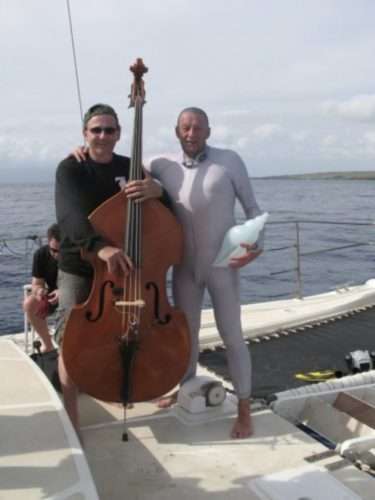
Pierre Lavagne de Castellan in Maui Hawaii, with David Rothenberg and Dan Sythe.
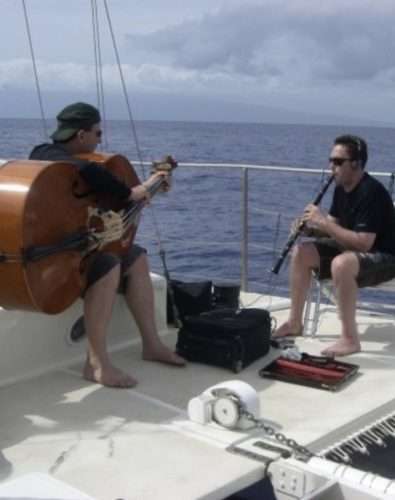
The search for the missing Kalinagos music...
It is known that humpback whales have been inspired for thousands of years by the music of the men who live on the shores of the areas they frequent. They have therefore built their musical repertoire in collaboration with these men. They then use this repertoire to pass on from generation to generation the proteodic songs, which they use for the functions we are developing here. However, in the Caribbean, the pre-Colombian populations, Tainos, Arrawacs, Caribbean, Kalinagos... have practically all been decimated. Only in Dominica do descendants of this population remain. The trauma of the invasion of their territory, the genocide they suffered and the colonization they experienced afterwards, caused them to lose most of their culture, including their music.
However, humpback whales have preserved this music, which they pass on, play and still use to convey their proteodic songs from generation to generation.
One of the goals of the Shelltone Whale Project is to recover this music from the whales of the Caribbean and to bring it back to the Kalinago people remaining in Dominica.



